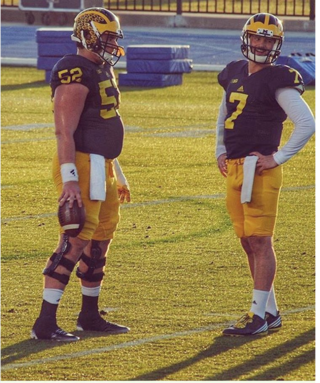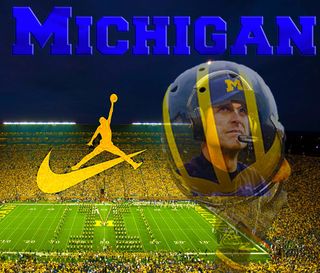Coaching
Harbaugh's Coaching Genius Strikes Again
What the SEC's Harbaugh envy is really about
Posted March 6, 2016
Before Harbaugh took his team south for Spring Break, Michigan QB, Shane Morris tweeted, “Best Spring Break trip ever coming up.”
During the trip, QB Wilton Speight tweeted“So fun being back out there with the boys. Now it's Beach time!”
After the trip cornerback Jourdan Lewis tweeted “Practice in Florida over its been real!”
“It was an awesome experience for the whole team - players, coaches, and staff,” says Michigan Tight End coach, Jay Harbaugh. “Obviously the actual practice was productive and sharp,” he says. “But I think we all found that the time spent bonding was the most fun - something you just don't always get as much at home.”
That’s because evolution designed our brains to pay particular attention to new environments for safety reasons. This heightened awareness makes such experiences more impactful, memorable and meaningful. They also promote group culture by the members sharing unique experiences. Humans are a social species and ‘belonging’ was key to survival for our ancestors. So when we feel inclusion the Ventral Tegmental Area (VTA) of the brain, which monitors social connectivity, releases dopamine (the brain’s happy dance drug).[1-4]
But SEC brains were not doing a happy dance.

SEC coaches were livid when they learned about Harbaugh’s plans. Not surprising, Harbaugh has been using the SEC’s last nerve as a trampoline, since he took over at Michigan – first the satellite camps, then the 41-7 Citrus Bowl beat down of Florida, and now this.
“We just haven’t seen widespread use of spring break for out-of-season practice,” SEC Commissioner, Sankey told USA Today. “It just seems the wrong tone and it’s viewed by me and (others) as the wrong direction.”
Wrong tone? Harbaugh is coaching a football team not playing a saxophone. Get real: the SEC’s upset about possible recruiting opportunities that might arise from Michigan practicing at IMG Academy in Bradenton.
“What galls the SEC is that Harbaugh sees things in 3-D while they never even realized they were in a box, let alone thought to think outside of it.” (USA Today)

As a neuroscientist, I always find it curious when the thinking and emotional parts of the brain clash. For example, NCAA president Mark Emmert expressed concern about Harbaugh encroaching on players’ off time.
However, by practicing during spring break, Michigan will have one less week of practice during the spring semester, meaning more time for academic study. Funny the thinking part of Emmert’s brain missed that, especially considering how much the NCAA insists college football players are amateur “student-athletes.” If that’s the case then that extra week is a great thing because education would matter most for the "student athlete." Yet, the NCAA didn’t applaud this… hmmm.
“I think the players - especially young guys - really enjoyed being able to begin spring ball on spring break because it let them ease into it more- rather than having to balance being thrown into two new things at once, class and practice,” says Harbaugh, who obviously cares about the student athlete’s education as much as their athletic performance.

A trip like this strengthens team membership and provides athletes with skills that are transferrable beyond playing pro sports. And most college players will not play in the NFL or CFL. So how is providing student athletes with skills that are useful wherever their life takes them moving in the wrong direction?
And why is the SEC trying to stop Jim Harbaugh from giving Michigan players these opportunities as opposed to trying to provide them for their teams?
It doesn’t seem logical because it is an emotional reaction in the old mammal brain, which is not capable of being logical. In this part of the brain, the mantra is “survives now and asks questions later.”[5] So naturally, the brain's happy dance drugs that winning a football game generates are more important to the old mammal brain than the welfare of the student athlete because this part of the brain is not capable of thinking[6] and seeing the big picture.
Plus, more dopamine is released on the anticipation of a reward than the actual reward. So recruiting an athlete becomes more important than developing and educating the student athlete because recruiting is associated with the anticipation of winning games in the old brain, whereas educating and developing the athlete is not. What's wrong with that picture?

Investing in the student athlete on an individual basis is vital because we are a social species, which means we are a team. And teams are as strong as their weakest members – and the game we play extends beyond the football field.
Our team builds our buildings, launches our space shuttles, grows our food, comforts our weary, and develops cures for our illnesses. Harbaugh’s actions come from the Prefrontal cortex (thinking part of the brain), and sadly, the SEC’s response is subcortical and comes from the old mammal brain, which is easily sustained with brief neurochemical rewards like winning a football game, without thinking or truly caring about the athletes involved, and the big picture - preparing an individual to thrive in society.

However, winning football games and caring about student athletes are not mutually exclusive concepts, as Harbaugh has repeatedly demonstrated. Win in the classroom, win in the community, and winning on the field naturally follows.
-Remain fabulous and phenomenal!
Join my email list to receive notifications of new posts
Or visit me at:
UCLA Center for the Neurobiology of Stress
References
1. Bearer, E.L., et al., Reward circuitry is perturbed in the absence of the serotonin transporter. Neuroimage, 2009. 46(4): p. 1091-104.
2. Bourdy, R. and M. Barrot, A new control center for dopaminergic systems: pulling the VTA by the tail. Trends Neurosci, 2012. 35(11): p. 681-90.
3. Bruhn, C., [The reward system of the brain: the brain loves surprises]. Dtsch Med Wochenschr, 2014. 139(18): p. 928-9.
4. Cooper, D.C., et al., A role for the subiculum in the brain motivation/reward circuitry. Behav Brain Res, 2006. 174(2): p. 225-31.
5. McEwen, B., Lasley, E, End of Stress as we know it. 2002, Washington, D.C.: Joseph Henry Press.
6. Wise, R.A. and P.P. Rompre, Brain dopamine and reward. Annu Rev Psychol, 1989. 40: p. 191-225.




